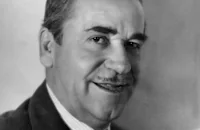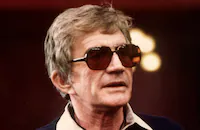This Man's Navy

Brief Synopsis
Cast & Crew
William A. Wellman
Wallace Beery
Tom Drake
James Gleason
Jan Clayton
Selena Royle
Film Details
Technical Specs

Synopsis
During World War II, Chief Aviation Pilot Ned Trumpet, jokingly called "Old Gas Bag" by some of his Navy pals, handles his lighter-than-air airship with ease as he and his crew make a difficult landing at the fog-enshrouded Lakehurst, New Jersey airfield. Ned, who often brags about his flying capabilities and is known to embellish his war stories, makes up one of his biggest lies when he tells his friends that he has a son. After recounting numerous stories about his "son," and insisting how proud he is of the boy, Ned panics, realizing that he will someday be expected to introduce his pals to hin. Ned finds the perfect young man to impersonate his son on the day that he falls from a hot air balloon and parachutes into a ranch owned by Maude Weaver. Maude lives with her son Jess, who is fascinated by Ned's flying stories. Before returning to his base, Ned suggests that the young man join the lighter-than-air service, unaware that Jess has a physical disability. Back with his flying buddies, Ned resumes his storytelling, referring to Jess as "his boy," and eagerly awaiting the day when he will be able to show him off. Although Ned soon discovers that Jess is disabled, he is determined to instill faith in the boy and help him realize his dreams. Ned arranges an operation to correct the problem with Jess's legs, and the operation is a success. Afterward, Ned proudly introduces his "son" to his pals, and though Ned has not told Jess about his lie, Jess goes along with the ruse. To Ned's delight, Jess lives up to his expectations and soon earns his flying license. One day, while on a submarine patrol mission, Ned becomes overly anxious to see Jess execute his first bombing, and orders an unauthorized and premature attack on a Japanese submarine. Jess's bomb misses its target, however, and when the submarine fires back, the airship is hit. Ned quickly takes over the controls and sinks the submarine, but, in the aftermath of the skirmish, Jess finds himself facing a court-martial for disobeying orders. The situation looks bad for Jess until Ned steps forward and takes the blame for his actions. When Jess later rejects Ned's friendship and asks to be transferred to the Ferry Command, Ned takes the request as an insult and ends his friendship with the young man. Some time later, while on assignment in Burma, Ned is visited by Jess, who has volunteered to fly a dangerous mission across enemy lines. Ned is still hurt by Jess's rejection, but when Jess's plane crashes in Japanese territory, he rushes to the scene with a rescue team. Both Ned and Jess emerge safely from the jungle and are reunited on a transport ship returning to the United States. In Lakehurst, Ned and Jess are decorated for their heroism, after which Jess indicates that he will be returning to the lighter-than-air service.

Director

William A. Wellman
Cast

Wallace Beery

Tom Drake

James Gleason
Jan Clayton

Selena Royle

Noah Beery Sr.

Henry O'neill

Steve Brodie
George Chandler

Donald Curtis
Arthur Walsh
Will Fowler
Frank Fenton

Paul Cavanaugh
Richard Crockett
Connie Weiler
Kathleen Williams
William Tannen
Tom O'grady
Jay Norris
Bob Mccutchin
Dick Rich
John Kellogg
Robert Sully
Johnnie James
Larry Thompson
Mel Schubert
Joe Sullivan
Bruce Kellogg
George Ramsey
Eddie Hall
Douglas Cowan
James Warren

Blake Edwards
Allen Ray
Arthur Space
Key Chang
Ralph Brooke
Stewart Garner
Vernon Downing
Crane Whitley

Henry Daniell
Jean Wong
Paul Singh
Ken Stewart
Don Shannon
Carlyle Blackwell Jr.
Bob Lowell
Richard Collin
Will Walls
Tom Trout
Phil Hanna
Bob Maclean
Bill Dyer
Jack Mattis
Brad Towne
Bob Thom
George Ryland
George Peters
Bob Miller
Crew
Hugh Allen
Peter Ballbusch
John Banse
Glen Barner
Howard Campbell
Borden Chase
Mark Davis
Kay Dean
Peter P. Decker
Cedric Gibbons
A. Arnold Gillespie
Commander Herman E. Halland U.s. Navy (ret.)
Horace Hough
Irene
Donald Jahraus
Lowell S. Kinsall
Lieut. Fred M. Lloyd U.s.n.r.
Sam Marx
Warren Newcombe
Leo Pepin
William J. Saracino
Lt. Comr. Clyde E. Schetter U.s.n.r.
John Schmitz
Douglas Shearer
Nathaniel Shilkret
Art Smith
William Steinkamp
Michael Steinore
Sidney Wagner
Irvine Warburton
John A. Williams
Edwin B. Willis

Photo Collections
Film Details
Technical Specs

Articles
This Man's Navy
Beery stars as Chief Ned Trumpet, a career military man who has earned the nickname "Old Gasbag" for his long-winded war stories and tall tales of service in China, India, and other exotic postings. In one of his many games of verbal one-upmanship with fellow officer and long-time buddy Chief Jimmy Shannon (James Gleason), he fabricates a son who is destined to follow in his footsteps, and almost immediately he is literally dropped into the lap of a young, fatherless man who dreams of flight. He "adopts" farmboy Jess (Tom Drake), playing godfather, matchmaker, and guardian angel until the boy arrives on base to thank his "father" and make him proud. At least until one combat crisis breaks Jess' spirit and he transfers out, breaking Trumpet's heart until they meet up again in India for the film's dramatic third act.
Long past his leading man days, the one-time silent screen villain and unlikely leading man Beery (who won an Oscar® for his sentimental 1931 turn as The Champ) had been putting his gravel voice and punching-bag kisser to work largely in comic roles for the past decade, usually playing blowhards and slobs with a heart of gold hidden under the rumpled exterior. As Trumpet, Beery had the opportunity to play hero along with the comedy. His bluster transforms to quiet strength and determination in combat, losing all ego and focusing on his mission and his men.
The young Tom Drake, immortalized as the Boy Next Door that Judy Garland pined for in Meet Me in St. Louis (1944), is adequately stalwart as the prodigal son, and the great character actor James Gleason underplays his role as both foil and friend to Trumpet. The lovely Jan Clayton, best known as Ellen on the TV show Lassie, gets a terrific introduction as a sassy, cynical diner cashier all but drafted by Trumpet to become Jess' girlfriend (her spirit and humor sadly melt away after they pair up). Wallace's older brother Noah Beery, Sr., in one of his last screen appearances, has a small role as a veteran LTA officer, and future writer/director Blake Edwards has an unbilled role as flier.
The lightweight melodrama about the Lighter Than Air Corps, written by fast-rising screenwriter Borden Chase (later to make his name with such superior "adult" westerns as Red River [1948] and Winchester '73 [1950]), follows a thoroughly conventional journey of triumph, setback, and redemption. What's less conventional is the focus on the LTA, a branch of the Armed Services rarely if ever seen in Hollywood's World War II dramas. The opening images of a massive blimp descending into the fog for a tricky landing, emerging from the mist over the air field as crews scramble to grab the mooring ropes and wrestle it to a landing, create a sense of majesty and mystery for the unconventional airliner. Even the comic intercutting of Beery's blustery tall tales, which he croaks out to a crew that rolls its eyes as if to say "Here we go again," doesn't undercut the visual drama of this introduction.
Director William Wellman was the natural choice for the film. The prolific Hollywood journeyman was a versatile director with successes in all genres, but before his Hollywood career he was a decorated World War I fighter pilot, having flown with the Lafayette Flying Corps, and it was an aviation drama that made his name. His 1927 World War I combat adventure Wings wowed audiences with its thrilling aerial footage and combat scenes and won the first Oscar® for Best Film.
This Man's Navy hasn't anywhere near the ambition or scope of Wings, but Wellman does bring dignity to the men of the LTA and grit to the combat scenes of an otherwise breezy military drama. The first taste of combat comes when Jess makes his maiden command voyage over the Eastern seaboard and spots a German U-boat in American waters and goes in for the kill. The slow-moving blimp becomes a giant target for the submarine gunner. Bullets rip through the fabric of the blimp and shatter the glass of the cockpit. As Jess recovers from the shock, he notices blood dripping on his uniform from the gunner's turret above, and Wellman cuts to show us the gunner slumped over his weapon. Later dialogue hints that the crew survived the attack, but what Wellman shows us is the brutality of combat and the fragility of the men under fire. The climactic scene, a rescue mission for a downed plane in the Indian jungle, is equally gritty and Wellman creates a tense escape as the blimp plays hide and seek in the clouds with attacking Japanese Zeroes.
The rest of the film plays like just another assignment for Wellman, another military programmer about the heroic men with comic interludes between missions, but these scenes give the otherwise familiar story a dramatic grit and a visual jump-start. It's easy to see where Wellman's interests lie in This Man's Navy, Hollywood's tribute to the unsung heroes of Lighter-Than-Air U.S. Naval and Marine Corps Aviation.
Producer: Samuel Marx
Director: William A. Wellman
Screenplay: Borden Chase, Herman E. Halland, Hugh Allen, Allen Rivkin, John Twist
Cinematography: Sidney Wagner
Film Editing: Cotton Warburton
Art Direction: Howard Campbell, Cedric Gibbons
Music: Nathaniel Shilkret
Cast: Wallace Beery (Ned Trumpet), Tom Drake (Jess Weaver), James Gleason (Jimmy Shannon), Jan Clayton (Cathey Cortland), Selena Royle (Maude Weaver), Noah Beery (Joe Hodum).
BW-100m.
by Sean Axmaker

This Man's Navy
Quotes
Trivia
Notes
Working titles for this film were Lighter Than Air and Air Ship Squadron No. 4. Onscreen credits include the following written acknowledgment: "This Man's Navy was made possible with the help, guidance and cooperation of Men of Lighter-Than-Air, U.S. Naval and Marine Corps. Aviation, U.S. Army Air Force, U.S. Navy Submarine Service, and Technical Supervision of Mr. Hugh Allen, Lt. Comdr. Clyde E. Schetter, U.S.N.R., Lieut. Fred M. Lloyd, U.S.N.R." A January 1944 Hollywood Reporter news item announced that the picture was to be directed by Willis Goldbeck. Goldbeck was replaced by William Wellman, an experienced flyer, in February 1944, according to Hollywood Reporter. A Hollywood Reporter production chart lists Reginald Owen in the cast, but he did not appear in the final film. A May 19, 1944 Hollywood Reporter production chart lists Paul Langton in the cast, but his appearance in the released film has not been confirmed.
Hollywood Reporter news items add the following information about the production: Broadway singer Bill Johnson was set to make his film debut in this picture, but his role was later assigned to James Gleason. Although Bert Spurlin was announced as an assistant director, the extent of his contribution to the completed film has not been determined. Jack Reilly, a young Navy cadet, was set for a "major" role, but he did not appear in the released film. Technical advisor Hugh Allen was the public relations executive of the Goodyear Aircraft Co. Location shooting, which was scheduled to take up approximately seventy-five percent of the total filming, was done at Navy dirigible bases in Lakehurst, New Jersey, and in Newhall, Santa Ana and Del Mar, CA. Shooting at the Santa Ana blimp hangar, which was reported to have been the largest interior ever filmed, took three nights to complete. Because a suitable Southern California location for filming the Burma airport sequence was not found, M-G-M built a jungle flying field on its Culver City back lot.















